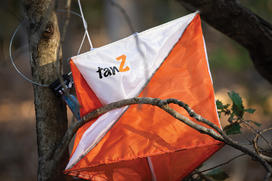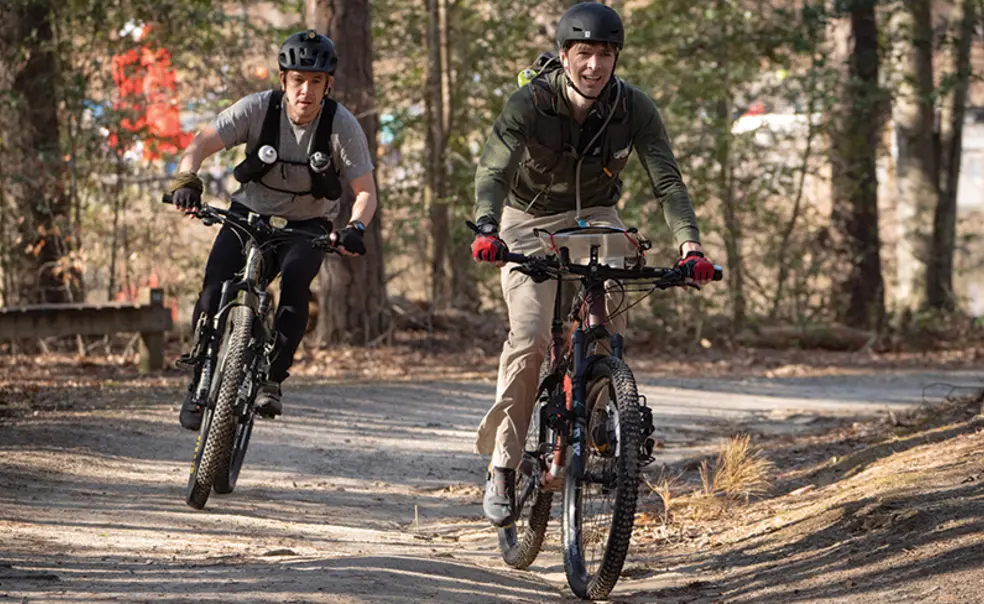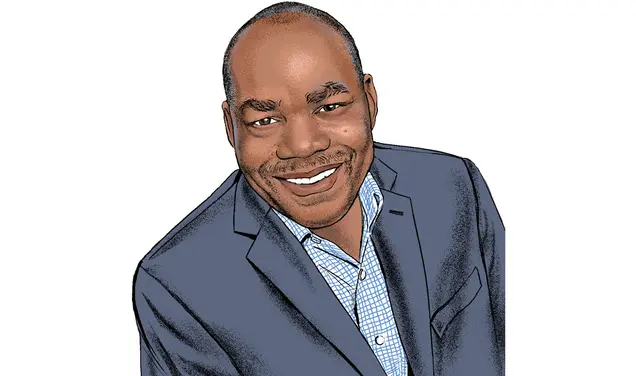Together, Tom Rassweiler ’02 and Pat Truxes ’02 Adventure Race
As anyone who has been on a group road trip knows, nerves fray and tempers can get short hours in. One person is hungry, another is exhausted, and the navigator may have missed the last turn.
Tom Rassweiler ’02 and Pat Truxes ’02 experienced all of that at the Frozen Foot Challenge in Chester, Virginia, in early March, except they did it on mountain bikes and on foot. Rassweiler and Truxes love adventure racing, an extreme sport that combines grueling physical and mental challenges. Their goal was to find as many checkpoints as they could, hidden among the hills, streams, trails, and woods of Pocahontas State Park. And they had 12 hours to find them.
Adventure racing is having a moment. It was featured in the 2024 film Arthur the King starring Mark Wahlberg and was profiled in a New York Times story in March centered on the 30-hour United States Adventure Racing Association National Championships last fall. As reporter Doug Bock Clark described it, adventure racing is “a mash-up of an Ironman triathlon and a wilderness treasure hunt.” Cellphones and GPS devices are forbidden, so teams must find their way using only a map, a compass, and their wits.
As adventure races go, the Frozen Foot Challenge was not particularly hard, Rassweiler and Truxes say, even for a couple of guys entering middle age. Races vary from as few as six hours to as long as 36 hours, all without scheduled rest breaks. Longer races, like the national championships, may include a canoeing section, but Frozen Foot required only running and biking.
Rassweiler, who lives in Manhattan, is a games designer for Microsoft. Truxes, a career U.S. diplomat, lives in northern Virginia. They met during freshman week when they both went on an Outdoor Action trip, and it proved to be a pivotal moment. The following year, they drove the OA support van, carrying equipment for that year’s entering class. When it came time to choose their adventure racing team name, they chose “OA Support,” their logo showing a van with canoes strapped to the roof.
The two roomed together for their final three years, and although they remained close after graduation, participating in each other’s weddings and sharing family vacations, they could feel the centrifugal pull of life tugging them apart. Extreme sports seemed
a way, unconventional perhaps, to resist that.
“Time is a precious resource, right?” Rassweiler says. “We’re separated geographically, work is crazy for both of us, plus family. We’re always looking for ways to maintain our friendship.” Adds Truxes, “With adventure racing, there’s a shared goal. And I get 12 hours to hang out with my best friend from college.”
Rassweiler took up adventure racing first with a work colleague. When he told Truxes about it, his old friend wanted in. For their first race together in 2021, Truxes says he bought a cheap mountain bike that fell apart on the trail, but he wanted to do more. They have now completed 14 races of various lengths and degrees of difficulty and ended 2024 as the top-ranked two-person team in the country. (Teams can have up to four members.)

For Frozen Foot, each team was issued topographical maps for the course the night before the race and spent hours planning the most efficient route. This race was divided into five segments, alternating between running and biking. There were 58 checkpoints, small electronic sensors hidden in the woods. The goal was to find as many as possible within the time limit, checking them off on an electronic clicker.
If the endurance part of adventure racing is obvious, the strategic part is more subtle. In the first segment, for example, a two and a quarter mile run with three checkpoints, most teams turned right out of the starting gate to get the easy first checkpoint a few hundred yards away. Rassweiler and Truxes headed left, figuring that they would get that checkpoint last and avoid being stuck behind those who had found it right off the bat and were waiting to check it off.
In his role as navigator, Rassweiler pores over the maps, which he either mounts to the front of his bike or carries around his neck, and announces where to go next. Truxes is the “punch monkey,” the one who carries the clicker and records each checkpoint, many of which are devilishly hidden in trees, dense thickets, or the sides of hills. He handles all the team’s logistics, such as arranging transportation and accommodations.
He is also responsible for ensuring that they have packed enough food and water to sustain them over a very tough day. They try to consume 200-300 calories of solid food and drink about a liter of water every hour, always while on the go. Over 12 hours or more, they can’t subsist on trail bars alone, so they also carry whole foods to provide a quick burst of carbs and protein. Among their favorites, believe it or not, are cold McDonald’s cheeseburgers bought the night before. Truxes carries a water purifier since there may not be fresh water sources out on the trail.
For a 12-hour race, there was no need for sleep, but in longer races, Rassweiler talks about the “4 a.m. dead zone” where they might nod off even while cycling. Truxes once woke himself by falling headfirst into a thorn bush. “You don’t embarrass yourself because you’re tired,” says Rassweiler. “You embarrass yourself because you’re lost.” Late in the day, tempers can get short when trying to locate a checkpoint the map says ought to be right in front of them.
“This is where our long friendship comes into play,” Truxes explains. “We’ve spent so much time together that we kind of know each other’s personalities. But there definitely have been times when we will get a little testy.”
The two finished seventh overall at Frozen Foot, second among two-person teams. They had a 15-hour race scheduled for late April in Williamsburg, Virginia, and the daunting 36-hour Cowboy Tough Adventure Race in Wyoming planned for August.
That’s a challenge for anyone, let alone a couple of 44-year-olds, but the challenge is what makes it fun. Says Rassweiler: “The thing that just lights me up about adventure racing is that blend of thinking, strategy, and endurance, all happening at the same time.”













No responses yet